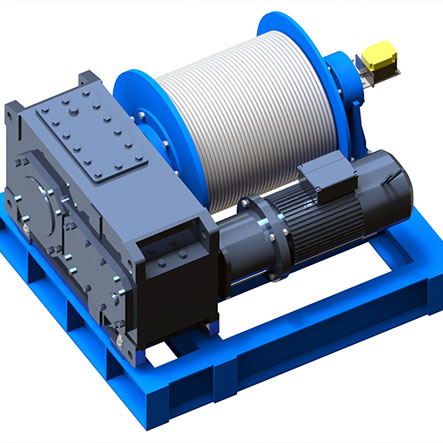Can a Winch be Used as a Hoist? Expert Insights and Safety Tips
Date: 2024-10-15 Share:
Understanding the Difference Between Winches and Hoists
Definition of a Winch
A winch is a mechanical device that is used to pull in, let out, or adjust the tension of a cable or line. It typically consists of a spool or drum that is powered by a crank, motor, or other means. Winches are often employed in various applications such as towing, pulling boats, and construction sites where materials need to be moved horizontally rather than lifted.
Definition of a Hoist
Hoists are tailored for lifting and lowering loads vertically using gears or pulleys to raise objects in a straight, up-and-down motion. They are frequently employed in warehouses construction sites and various industrial settings where there is a need to move objects vertically.
Key Differences in Mechanisms
The primary difference between a winch and a hoist lies in their mechanisms and intended uses. While winches are generally used for horizontal pulling, hoists focus on vertical lifting. Additionally, winches often feature a direct pull mechanism, whereas hoists use a more complex gear system for efficient weight distribution and lifting capability.
Applications and Typical Use Cases
Winches are commonly used in settings well as, in construction and off-road vehicles to haul heavy loads or aid in rescue missions while hoists are frequently seen in industrial environments where the lifting of components or materials is crucial for daily activities Understanding these various uses can assist in selecting the appropriate equipment, for particular tasks.
When to Consider Using a Winch as a Hoist
Assessing Load Requirements
When you’re thinking about using a winch to lift something or move objects around it’s important to figure out how much weight the job requires. Different winches can handle loads depending on how they’re built while hoists usually have consistent lifting limits. Think about how heavy the load is and make sure the winch is, up to the task, without any risks.
Safety Precautions
Safety is important when operating any lifting equipment, like a winch used as a hoist; it’s crucial to verify that it is intended for lifting purposes specifically and take extra care to properly secure the load and monitor the strain on the machinery to avoid any mishaps or harm to people or equipment.
Industry Standards and Regulations
Understanding industry norms and rules is crucial when thinking about using a winch as a hoisting machine as organizations, like OSHA (Occupational Safety and Health Administration) and ASME (American Society of Mechanical Engineers) have set out regulations to guarantee operations and equipment reliability adhering to these guidelines can reduce risks linked to lifting tasks.
Mechanical and Operational Considerations
Weight Capacity Limitations
When considering using a winch, as a tool for lifting tasks it’s crucial to take into account the weight capacity it can handle safely and effectively without risking equipment failure or accidents due, to overloading it beyond its rated limits.
Gear System Differences
Winches and hoists often use gear systems that are designed for tasks they perform differently in terms of gear setups – winches are better, for pulling tasks while hoists excel in providing mechanical advantage for vertical lifting due to their intricate gearing systems This difference is crucial, for ensuring safety and maximizing effectiveness.
Power Source Variability
When assessing winches and hoists side, by side it’s crucial to look at their power sources and their functionalities in different applications. The power source, for winches, can vary from operation to hydraulic systems; on the contrary, hoists usually rely on electric or pneumatic power by default. It is important to select a tool that matches its power system with needs and existing infrastructure.
Safety Tips for Using a Winch as a Hoist
Ensuring Proper Equipment Maintenance
Regular maintenance is key, to operating a winch when it’s used as a hoist; checking for wear and tear and making sure all parts work properly can help avoid issues while using it and improve safety overall.
Load Testing Procedures
Pre-operational Inspection
It’s important to inspect all the equipment before lifting any loads to avoid any accidents or malfunctions, during operation. Make sure to check the winch parts like cables, hooks, and pulleys for any damage or issues. This helps in catching any problems. Prevents them from escalating into bigger issues while working.
Periodic Inspection Frequency
Regularly scheduling inspections is crucial, for upholding safety protocols within a work environment to prevent equipment malfunctions and uphold safety regulations based on how the equipment is used and the types of loads it carries out Consulting manufacturer guidelines and industry regulations can offer detailed recommendations, on when to conduct these inspections.
Correct Usage Techniques
Operating a winch as a hoist safely and efficiently requires techniques to ensure effective lifting procedures are followed at all times. It’s crucial to adhere to the correct lifting angles and use the rigging to secure the load. Maintaining communication, with team members throughout operations is essential, for an outcome. By receiving training and staying vigilant in the workplace environment the likelihood of incidents can be significantly minimized.
Product Recommendations from NANTE
NANTE Electric Winches: Features and Benefits
NANTE provides a variety of winches for a range of uses that are both versatile and dependable, in different scenarios. They are known for their build quality and high pulling capacity well as advanced safety features. The user-friendly controls and efficient power usage make them a popular choice, for professionals and industrial environments.
Specifications of Popular Models
NANTE offers a range of known models, like the NANTE Electric Wire Winch and the NANTE Heavy Duty Winch that cater to load capacities and operational requirements with great performance, for towing and material handling tasks.
Applications for NANTE Winches in Lifting Operations
NANTE winches are great, for pulling tasks. Can also be used for controlled lifting, in situations where safety protocols are observed They are versatile and can be incorporated into different projects to improve operational efficiency overall.
NANTE Electric Hoists: Features and Benefits
“Nantes electric hoists are designed to prioritize safety and efficiency when lifting vertically. With cutting edge motor technology and safety features, against overloading in place they offer a user interface, for a secure operation.”
Overview of Different Models
At Nante’s disposal are a range of hoists, with designs tailored to handle various lifting loads and heights efficiently for a wide array of industrial needs and applications.
Specific Use Cases for NANTE Hoists
The NANTE hoists stand out in scenarios that call for lifting things, like construction sites or manufacturing plants and maintenance workshops Their consistent performance aids in simplifying tasks and boosting productivity at work making them a popular option, among professionals.
Conclusion: Making an Informed Decision on Winch and Hoist Usage
In conclusion, while winches can be used in some applications for lifting purposes, they are designed primarily for pulling tasks. Understanding the differences between winches and hoists, alongside adhering to safety guidelines and equipment specifications, is crucial for determining the best tool for the job. By considering load requirements, equipment capabilities, and suitable applications, professionals can make informed decisions that prioritize safety and operational efficiency.




